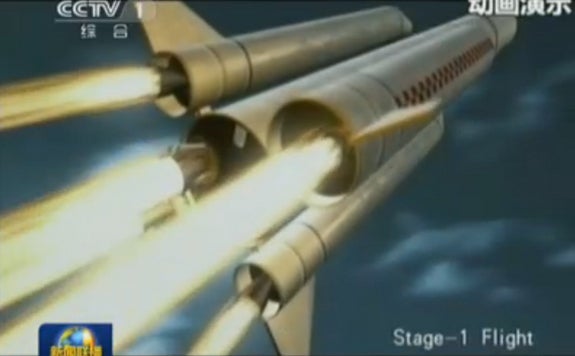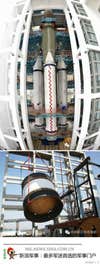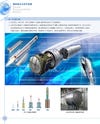China’s Largest-Ever Space Rocket Takes Another Big Step Forward
Hainan Island is becoming China's Cape Canaveral


Long March Assembly Pad
On sunny, tropical Hainan Island, China is assembling its largest-ever space rocket, the Long March 5. Chinese authorities state that this LM-5 prototype will launch in early 2016 from the Wenchang Space Launch Center. The LM-5 is a 62-meter-tall, 800-ton rocket which can carry up to 25 tons into low Earth orbit, or a 14-ton spacecraft bound for Mars or the Moon.

Take Off

Long March 5 Variants
This official CASIC (China’s space launch vehicle manufacturer) displays pictures of the Long March rocket deploying a satellite after launch, as well as showing the next generation of Long March rocket families at the bottom, including the Long March 5 in its 14 ton and 25 ton payload versions, the super heavy Long March 9, and the solid fueled Long March 11.
The assembly testing is a vital step in testing systems integration, on key parts like electrical equipment, sensors and connective valves. As a promising start for the LM-5’s progress, its YF-100 engine will be first tested this year by the launch of the Long March 6 light space launch rocket (the medium Long March 7 space launch rocket also uses the YF-100). Producing thrust up to 120 tons, the YF-100 uses liquid oxygen and kerosene as its propellants, providing a more environmentally friendly burn compared to current Chinese propellants. The LM-5’s diameter, a large 5 meters, would allow it to carry outsized loads like advanced spy satellites, Shenlong spaceplane and Shenzhou manned space capsules, as well as the modules for China’s new Tiangong 2 space station.

Long March Rocket Family
China’s progress in building a large space rocket would boost its military and scientific space capabilities in significant ways. As mentioned, the LM-5 would allow China to launch larger (and more effective) spy imaging satellites and unmanned spaceplanes. But its heavy launch capability would also give Chinese scientists the means not only to send space probes, orbiters and rovers to just Mars and the Moon, but also beyond the asteroid belt to the gas giants and their mysterious moons.
You may also be interested in:
Next Generation of Chinese Space Launch Vehicles Begins Its Long March (By Standing Up)
Chinese Laser Zaps Space, For World Peace
New, Better Chinese Spy Satellite Hits Orbit
CHEOS- China’s New Eye in Space?
Offset This! China’s Hypersonic Glider Flies for the Third Time This Year
The Little Space Tug that Can